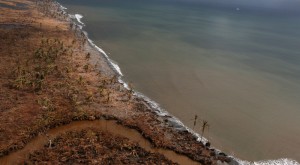Agri dep’t acts to help small fishermen affected by ‘Yolanda’

This aerial photo shows the devastation caused by last week’s typhoon which lashed Leyte province, near the coastal town of Tanawan, in central Philippines Sunday, Nov. 17. 2013. AP FILE PHOTO
MANILA, Philippines—The Department of Agriculture said Monday it has included among its priorities the construction of hundreds of fishing boats and the production of nets and other fishing gear to help soften the impact of Supertyphoon ‘‘Yolanda’’ on the country’s food security.
Agriculture Secretary Proceso J. Alcala said that in support of small-scale fishermen, his department was overseeing the construction of 1,300 fishing boats that will be equipped with 5-horsepower engines.
Alcala said that 4,000 fishing nets were also to be fabricated and distributed to affected municipal fishermen.
“The department is also set to position a total of 200 ‘payaos’ amounting to P40 million,” he said, referring to floating fish aggregating devices. The devices attract small fish which in turn attract larger, high-value species that are then easier to catch.
Last week, the Food and Agriculture Organization appealed to international donors for an initial $24 million, which would be used to cover the bill for immediate interventions in fisheries and agriculture in the aftermath of Yolanda.
Article continues after this advertisementThis was part of a United Nations-coordinated humanitarian flash appeal that called for $301 million in aid for the Philippines.
Article continues after this advertisementThe FAO called for emergency and rehabilitation efforts, including those for storage and irrigation facilities and support to fishing communities.
The Rome-based agency, which is part of the UN system, has released $1 million from its own funds, allotted mainly to provide seeds and fertilizer to affected farmers.
According to the FAO, the damage Yolanda wrought specially on the agriculture, fishery and forestry sector could have a deep impact on the food supply chain and food security.
The FAO took note of wide-scale destruction of storage facilities and rural infrastructure, including boats and fishing gear. This complemented an assessment by the International Rice Research Institute in Laguna which said that the typhoon’s worst effects would be due to extensive losses in farm machinery, storage, housing, and damage to roads and irrigation.